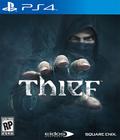Thief: The Dark Project is an oft-forgotten classic of 1990s PC gaming. It's easily the PC's answer to Metal Gear Solid, as it introduced tons of stealth mechanics that only later came to consoles. From dragging away unconscious bodies to using actual shadows as your ally, it crested almost every major innovation in the genre since, and it challenged you to use all of them to be a master thief. Thief is a reboot of the series, and it's currently in development for next-gen systems. At E3, we got some time with Theif to see what the game can do.
The new Thief still casts you as Garret, the thief from the classic games who wants to become a master thief of priceless goods. In the demo, this meant stealing a diamond from a "Baranoid" local lord. Fortunately, he's angered a lot of people and the guards are partially distracted by an angry mob as Garret enters the map. From there, his basic tools came into play, and the game mixes elements of the Assassin's Creed series with the PC series' iconic core.
Thief controls loosely like a first-person shooter, with tunings specific to its stealth underpinnings. You don't switch weapons. The game automatically alternates between your melee sap and your bow as needed, leaving arrow types as the only choice you need to make. This is handled with a radial menu, and the PS4 build allowed you to use the touch pad. The game also gives you the classic meter to see how much light you are in, along with a few new basic tools. You have a quick dash to move between points and a focus mechanic that slows time and provides advantages such as seeing sounds whose source can't be observed, highlighting guards in the shadows, and seeing inside locks to facilitate lock-picking. Focus is limited by a gauge that burns like a candle, and it does not regenerate. Health also doesn't regenerate, but there are health pick-ups.
The series' dark-fantasy roots are preserved in the gritty and exceptionally detailed environments. As Garret progressed into the lord's house, you could get through each area in several ways, but Eidos representatives highlighted that it would be exceptionally difficult to go completely unnoticed while clearing the map. Some options include jumping down a stairwell, throwing a bottle to lead the guard away, or running over to set off a dog and then climbing up a ledge and down the stairs.
A few other tools and tricks popped up throughout the demo, including third-person climbing sequences, which handled very similarly to Assassin's Creed, but with a new rappelling mechanic and a more focused feel. You can steal maps and money from guards (the maps are highlighted and have notes!), knocking down chandeliers to disable guards, and avoiding or disabling traps, and dealing with a puzzle that mixed Resident Evil 4-style puzzle-solving with some map-searching. The levels are about as open as they were in the original, so there are many ways to solve each area, observation is often rewarded, and screwing up doesn't always mean that the game is immediately over.
The graphics don't seem too far beyond what a well-optimized PS3 could handle, until you noticed that it was running at a smooth 60 frames per second without a dip. The soundscape, however, was where the game really showed its stuff. From guard voices to footsteps and the classical-styled music, the game knows how to paint a scene with audio before the graphics even come in. The latter half of the demo, which involved getting past a burning bridge, highlighted crackling, disturbingly realistic fires, collapsing objects galore, and occasional bits of set pieces amidst multipath areas.
Thief brings back a classic franchise, complete with its original difficulty and complexity and some high-def spit and polish. It only loses the obtuse controls in its transition to multiple platforms, producing a possible must-buy for the new console generation.
More articles about Thief











 Thief is a reinvention of a classic franchise that allows players to take on the role of Garrett, THE master thief. When the city that created and defines him is threatened, Garrett must step from the shadows and uncover the truth before his world is torn apart forever.
Thief is a reinvention of a classic franchise that allows players to take on the role of Garrett, THE master thief. When the city that created and defines him is threatened, Garrett must step from the shadows and uncover the truth before his world is torn apart forever.























